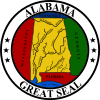Flag of Alabama
 | |
| Name | none |
|---|---|
| Proportion | 2:3 |
| Adopted | February 16, 1895 |
| Design | St. Patrick’s flag |
 Variant flag of Alabama | |
| Name | Flag of the Governor of Alabama |
| Design | The State Flag with the state military crest and Coat of Arms of Alabama in the lower and upper sections |
The current flag of Alabama (the second in Alabama state history) was adopted by Act 383 of the Alabama state legislature on February 16, 1895:[1]
The flag of the State of Alabama shall be a crimson cross of St. Andrew on a field of white. The bars forming the cross shall be not less than six inches broad, and must extend diagonally across the flag from side to side." – (Code 1896, §3751; Code 1907, §2058; Code 1923, §2995; Code 1940, T. 55, §5.)
The cross of St. Andrew referred to in the law is a diagonal cross, known in vexillology as a saltire. Because the bars must be at least six inches (150 mm) wide, small representations of the Alabama flag do not meet the legal definition.
History[]
1861 flag[]


On January 11, 1861, the Alabama Secession Convention passed a resolution designating an official flag. Designed by several women from Montgomery, final touches were made by Francis Corra of that city.[2] One side of the flag displayed the Goddess of Liberty holding an unsheathed sword in her right hand; in her left she held a small blue flag with one gold star. Above the gold star appears the text "Alabama" in all capital letters. In an arch above this figure were the words "Independent Now and Forever".[3] The reverse side of the flag had a cotton plant with a coiled rattlesnake. The text "Noli Me Tangere", ("Touch Me Not" in Latin), was placed below the cotton plant. This flag was flown until February 10, 1861, when it was removed to the Governor's Office after it was damaged by severe weather. It was never flown again.[3]
Current flag[]
Alabama's current flag was adopted in 1895. The legislation introduced by Representative John W. A. Sanford Jr. stipulates that "[t]he flag of the state of Alabama shall be a crimson cross of St. Andrew on a field of white. The bars forming the cross shall be not less than six inches broad, and must extend diagonally across the flag from side to side."[4] Sanford's father, John W. A. Sanford, had commanded the 60th Alabama Infantry Regiment during the U.S. Civil War and he modeled his design on the battle flag used by that regiment.[5] The design of that regimental flag was a white saltire over a blue field with a circle of white stars surrounding the crossing. It had been adopted from the flag of Hilliard's Legion of Alabama Volunteers which was raised in 1862 and dissolved after the Battle of Chickamauga with parts of its 1st and 3rd battalions entering the 60th Alabama Infantry. The regimental flag accompanied them through the end of the war and was surrendered at Appomattox Courthouse.

The saltire of Alabama's flag most closely resembles the saltire of the flag of Florida, which has its heritage in the Spanish Cross of Burgundy. Southern Alabama was originally part of Spanish Florida and subsequently West Florida. Although Alabama's adoption of its flag design predates that of Florida's by five years (1895), the 1868–1900 Seal of Florida depicted a white flag with a red saltire, similar to Florida's current flag or a Burgundian saltire, on top of a steamboat. Alabama's flag is officially a St. Andrew's cross as described in its legislation. This represents the cross on which St. Andrew was crucified.
It is sometimes believed that the crimson saltire of the current flag of Alabama was designed to resemble the blue saltire of the Confederate Battle Flag. Many battle flags were square, and the flag of Alabama is sometimes also depicted as square. The legislation that created the state flag did not specify that the flag was to be square, however.[6] The authors of a 1917 article in National Geographic expressed their opinion that because the Alabama flag was based on the Battle Flag, it should be square.[7] In 1987, the office of Alabama Attorney General Don Siegelman issued an opinion in which the derivation from the 60th Alabama Battle Flag is indicated, and also concluded that the proper shape is rectangular, as it had been depicted numerous times in official publications and reproductions;[5] despite this, the flag is still often depicted as being square, even in official publications of the U.S. federal government.[8]
Another remote, but possible inspiration was the flag carried by Co. "F", 7th Alabama Cavalry. The regiment was the only Alabama regiment in , commanded by Col. Edmund Rucker of Tennessee (later Alabama), who became a prominent Birmingham businessman after the war. The flag of Rucker's brigade utilized a white background with a red saltire charged with 13 blue/green stars. This flag was given to Co. "F", 7th Alabama Cavalry by Rucker so that they might act as his Color Guard, and is held by the Alabama Department of Archives and History as part of its Alabama Civil War Period Flag Collection.[9] But the flag carried by Co. F 7th Alabama was not an Alabama flag, it was the flag made for Rucker's Brigade a month before the 7th joined his brigade; the 7th was color party only after September 24, 1864. A bunting flag that exists, in the white and red configuration with 13 blue stars, is not believed to be Alabama-associated, but rather to be tied to Rucker's Brigade, as well.
Governor's flag[]
The flag of the governor of Alabama is a variant of the state flag. In the top saltire, the flag displays the state coat of arms. The bottom saltire contains the state military crest which consists of a cotton plant with full bursting boll.

Flag of the Governor since 1939

Flag of the Governor 1868–1939
See also[]
- Spanish Empire
- Flag of Florida
- Flag of Jersey
- Great Seal of the State of Alabama
- Saint Patrick's Saltire
- State of Alabama
- Symbols of the State of Alabama
References[]
- ^ "Official Symbols and Emblems of Alabama: State Flag of Alabama". Alabama Department of Archives & History. Retrieved June 15, 2012.
- ^ Robert B. Bradley (2000). "Flags of the Confederacy – Flags of Alabama". Flags of the Confederacy. Flags of the Confederacy. Retrieved November 17, 2007.
- ^ a b Alabama Department of Archives & History (2001). "The Secession Convention Flag". Retrieved November 17, 2007.
- ^ Code of 69 (1975) § 1-2-5
- ^ a b Don Siegelman (1987). "Opinion of Don Siegelman" (PDF). Office of the Attorney General of the State of Alabama. Archived from the original (PDF) on April 14, 2008. Retrieved November 17, 2007.
- ^ Alabama Department of Archives & History (2007). "State Flag of Alabama". Retrieved November 17, 2007.
- ^ *Lt. Commander Byron McCandless & Gilbert Grosvenor. "Flags of the World." National Geographic Magazine. Vol 32. No. 4, pp. 281–420 (October 1917).
- ^ "Our Flag" (PDF). U.S. Government Printing Office. 2007. Archived from the original (PDF) on August 5, 2010.
- ^ Flag: Rucker's Brigade (Carried by Co. F, 7th Alabama Cavalry) Catalogue No. 86.1876.1
External links[]
- Alabama State Flag at the Alabama Department of Archives & History
- written account of the flag in 1987 by Don Siegelman, Alabama Attorney General
- United States state flags
- Symbols of Alabama
- Saltire flags
- Flags of Alabama
- Red and white flags
- Flags introduced in 1895
- 1895 establishments in Alabama



